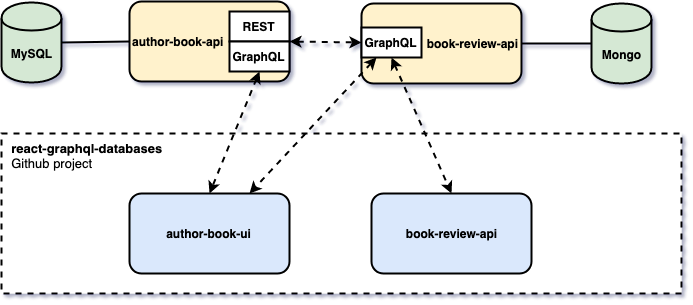The goal of this project is to explore GraphQL. For it, we will implement two Spring Boot Web Java applications: author-book-api and book-review-api.
Note: In
kubernetes-minikube-environmentrepository, it's shown how to deploy this project inKubernetes(Minikube)
-
Spring BootWeb Java application that handlesauthorsandbooks. It exposes aGraphQLendpoint and traditional REST API endpoints.author-book-apiusesMySQLas storage and callsbook-review-apito get the reviews of the books. It usesFeignto easily create a client forbook-review-apiandResilience4j(fault tolerance library) to handle fallback whenbook-review-apiis down. The bookISBNis what connects books stored inauthor-book-apiwith the ones stored inbook-review-api. -
Spring BootWeb Java application that handlesbooksand theirreviews. It only exposes aGraphQLAPI and usesMongoDBas storage.
In the repository react-graphql-databases, I have implemented two ReactJS applications author-book-ui and book-review-ui that are frontend applications for author-book-api and book-review-api, respectively.
If you want to see the complete communication frontend-backend using GraphQL, clone the react-graphql-databases and follow the README instructions.
-
Open a terminal and inside
springboot-graphql-databasesroot folder rundocker-compose up -d -
Wait for containers to be with status
running (healthy). To check it, rundocker-compose ps
Inside springboot-graphql-databases, run the following Maven commands in different terminals
-
author-book-api
./mvnw clean spring-boot:run --projects author-book-api \ -Dspring-boot.run.jvmArguments="-Dspring.datasource.username=authorbookuser -Dspring.datasource.password=authorbookpass" -
book-review-api
./mvnw clean spring-boot:run --projects book-review-api \ -Dspring-boot.run.jvmArguments="-Dspring.data.mongodb.username=bookreviewuser -Dspring.data.mongodb.password=bookreviewpass"
-
Open a terminal and make sure you are in
springboot-graphql-databasesroot folder -
In order to build the docker images, run the following script
./docker-build.sh
-
author-book-api
Environment Variable Description MYSQL_HOSTSpecify host of the MySQLdatabase to use (defaultlocalhost)MYSQL_PORTSpecify port of the MySQLdatabase to use (default3306)ZIPKIN_HOSTSpecify host of the Zipkindistributed tracing system to use (defaultlocalhost)ZIPKIN_PORTSpecify port of the Zipkindistributed tracing system to use (default9411)BOOK_REVIEW_API_HOSTSpecify host of the book-review-apiservice (defaultlocalhost)BOOK_REVIEW_API_PORTSpecify port of the book-review-apiservice (default9080) -
book-review-api
Environment Variable Description MONGODB_HOSTSpecify host of the MongoDBdatabase to use (defaultlocalhost)MONGODB_PORTSpecify port of the MongoDBdatabase to use (default27017)ZIPKIN_HOSTSpecify host of the Zipkindistributed tracing system to use (defaultlocalhost)ZIPKIN_PORTSpecify port of the Zipkindistributed tracing system to use (default9411)
-
In a terminal, make sure you are inside
springboot-graphql-databasesroot folder -
Run following script
./start-apps.sh
| Application | URL Type | URL |
|---|---|---|
| author-book-api | Swagger | http://localhost:8080/swagger-ui.html |
| author-book-api | GraphiQL | http://localhost:8080/graphiql |
| book-review-api | GraphiQL | http://localhost:9080/graphiql |
-
book-review-api
-
In a browser, access http://localhost:9080/graphiql
-
Create a book and return its id
mutation { createBook(bookInput: {title: "Learning GraphQL and Relay", isbn: "9781786465757"}) { id } } -
Add one review for the book created above, suppose the id is
5bd4bd4790e9f641b7388f23mutation { addBookReview(bookId: "5bd4bd4790e9f641b7388f23", reviewInput: {reviewer: "Ivan Franchin", comment: "It is a very good book", rating: 5}) { id } } -
Get all books stored in
book-review-api, including their reviews{ getAllBooks { id title isbn reviews { comment rating reviewer createdAt } } }
-
-
author-book-api
-
In a browser, access http://localhost:8080/graphiql
-
Create an author and return its id
mutation { createAuthor(authorInput: {name: "Samer Buna"}) { id } } -
Create a book and return the book id and author name
Note: while creating this book in
author-book-api, we are setting the same ISBN,9781786465757, as we did when creating the book inbook-review-api.mutation { createBook(bookInput: {authorId: 1, isbn: "9781786465757", title: "Learning GraphQL and Relay", year: 2016}) { id author { name } } } -
Get author by id and return some information about his/her books including reviews of the book from
book-review-api.Note: as the book stored in
author-book-apiandbook-review-apihas the same ISBN,9781786465757, it's possible to retrieve the reviews of the book. Otherwise, an empty list will be returned in casebook-review-apidoes not have a specific ISBN or the service is down.{ getAuthorById(authorId: 1) { name books { isbn title bookReview { reviews { reviewer rating comment createdAt } } } } } -
Update book title and return its id and new title
mutation { updateBook(bookId: 1, bookInput: {title: "Learning GraphQL and Relay 2"}) { id title } } -
Delete the author and return his/her id
mutation { deleteAuthor(authorId: 1) { id } }
-
-
Zipkin
It can be accessed at http://localhost:9411
-
MySQL monitor
docker exec -it mysql mysql -uauthorbookuser -pauthorbookpass --database=authorbookdb show tables; select * from authors; select * from books;Type
exitto get out of MySQL monitor -
MongoDB shell
docker exec -it mongodb mongo -ubookreviewuser -pbookreviewpass --authenticationDatabase bookreviewdb use bookreviewdb; db.books.find().pretty();Type
exitto get out of MongoDB shell
- To stop applications
- If they were started with
Maven, go to the terminals where they are running and pressCtrl+C - If they were started as a Docker container, go to a terminal and, inside
springboot-graphql-databasesroot folder, run the script below./stop-apps.sh
- If they were started with
- To stop and remove docker-compose containers, network and volumes, go to a terminal and, inside
springboot-graphql-databasesroot folder, run the following commanddocker-compose down -v
To remove the Docker images created by this project, go to a terminal and, inside springboot-graphql-databases root folder, run the following script
./remove-docker-images.sh
- study how to implement authentication/authorization to
GraphQLendpoint; - implement
graphqlsubscription;
